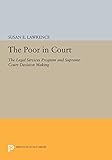The Poor in Court : The Legal Services Program and Supreme Court Decision Making / Susan E. Lawrence.
Material type: TextSeries: Princeton Legacy Library ; 1129Publisher: Princeton, NJ : Princeton University Press, [2014]Copyright date: ©1990Edition: Course BookDescription: 1 online resource (220 p.)Content type:
TextSeries: Princeton Legacy Library ; 1129Publisher: Princeton, NJ : Princeton University Press, [2014]Copyright date: ©1990Edition: Course BookDescription: 1 online resource (220 p.)Content type: - 9780691608693
- 9781400861460
- 344.73/03258 347.3043258 20
- KF336
- online - DeGruyter
- Issued also in print.
| Item type | Current library | Call number | URL | Status | Notes | Barcode | |
|---|---|---|---|---|---|---|---|
 eBook
eBook
|
Biblioteca "Angelicum" Pont. Univ. S.Tommaso d'Aquino Nuvola online | online - DeGruyter (Browse shelf(Opens below)) | Online access | Not for loan (Accesso limitato) | Accesso per gli utenti autorizzati / Access for authorized users | (dgr)9781400861460 |
Frontmatter -- Contents -- Preface -- List of Tables -- CHAPTER ONE. Introduction: Access to the U.S. Supreme Court -- CHAPTER TWO. Philosophies of Legal Assistance and Access to the Courts -- CHAPTER THREE. Appealing to the Supreme Court -- CHAPTER FOUR. Getting on the Court's Decision Agenda -- CHAPTER FIVE. Decision Making in LSP Cases -- CHAPTER SIX. The LSP's Role in the Development of Law -- CHAPTER SEVEN. Conclusion: Litigants, the Court, and Democracy -- APPENDIX A: Research Methods -- APPENDIX B: LSP Review and Success Rates by Year, 1966-1974 Terms -- APPENDIX C: Review and Success Rates of Selected Groups before the Supreme Court -- APPENDIX D: LSP Cases Remanded -- APPENDIX E: Agreement Rates between Justices in LSP Cases and the Court's Entire Docket, 1966-1974 Terms -- Bibliography -- Table of Cases Cited -- Index
restricted access online access with authorization star
http://purl.org/coar/access_right/c_16ec
Focusing on the Supreme Court as an integral part of the policy-making process, Susan Lawrence examines how a change in who has access to the Court, and the nature of the institutions that structure that access, has affected its agenda setting and doctrinal development. In her analysis of cases sponsored by the Legal Services Program (LSP) before the Supreme Court during the 1966 through 1974 terms, she explores the effect of this agency in creating a voice for the poor in the judicial policy-making process. The Court's response to cases presented by the LSP--as exemplified in its decisions to invalidate residency requirements for welfare recipients (Shapiro v. Thompson, 1969) but uphold maximum family grants (Dandridge v. Williams, 1970)--is described as emerging from a timely combination of new litigant claims, available legal bases, and judicial values and role conceptions, all of which were shaped by the political climate of the era. Lawrence convincingly argues that litigation before the Court is a powerful method of political participation for the disadvantaged.Originally published in 1990.The Princeton Legacy Library uses the latest print-on-demand technology to again make available previously out-of-print books from the distinguished backlist of Princeton University Press. These editions preserve the original texts of these important books while presenting them in durable paperback and hardcover editions. The goal of the Princeton Legacy Library is to vastly increase access to the rich scholarly heritage found in the thousands of books published by Princeton University Press since its founding in 1905.
Issued also in print.
Mode of access: Internet via World Wide Web.
In English.
Description based on online resource; title from PDF title page (publisher's Web site, viewed 30. Aug 2021)


